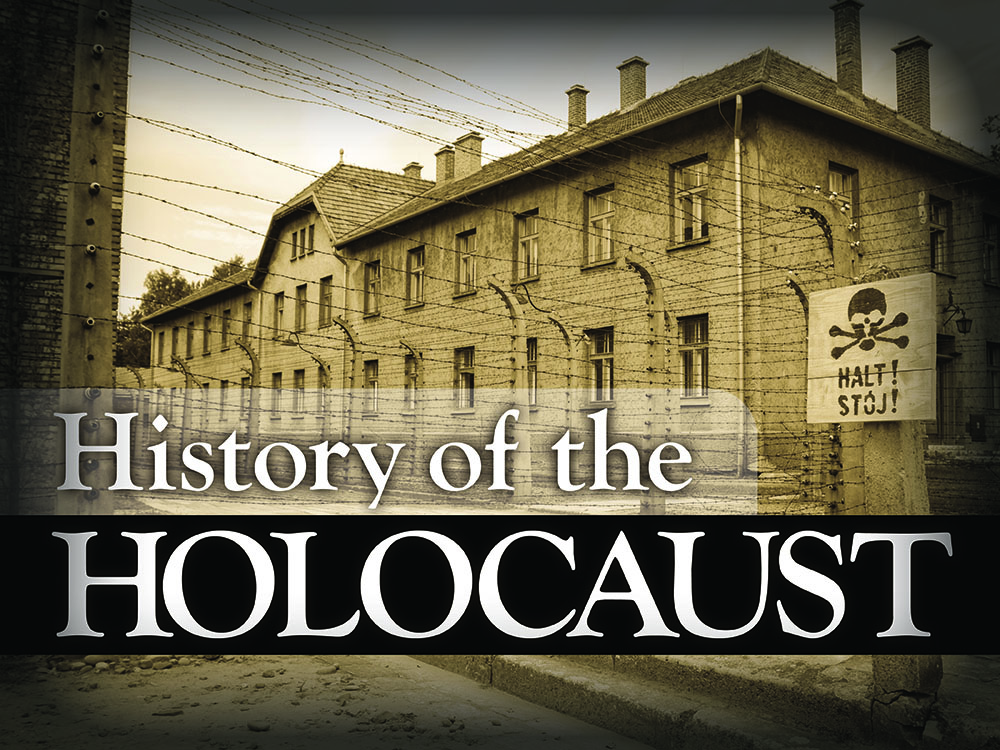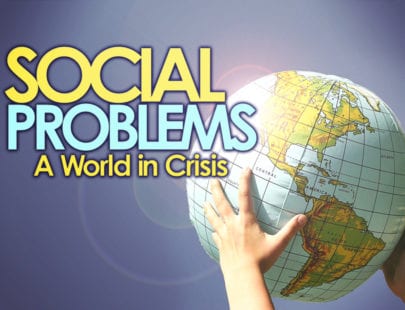
History of the Holocaust
“For the dead and the living, we must bear witness.” Discover the harrowing details of the history of the rise of anti-Semitism that contributed to the start of the Holocaust and the power of the Nazi party. Learn of the persecution of European Jews and other groups, and the tremendous aftermath for everyone involved in World War II, and what has been done since to combat genocide.
Units at a Glance
Unit 1: The Rise of Anti-Semitism
The Holocaust, the state-sponsored, intentional, and systemic extermination of the Jewish people of Europe, has its roots in earlier traditions of anti-Semitism. From the early Christian church to the anti-Semitism of social Darwinism in the late 19th century, the widespread prejudice against the Jews enabled Adolf Hitler and the Nazi party to enact broad-ranging legislation against Jews and other non-Aryan peoples in Germany.
What will you learn in this unit?
- Understand the history of anti-Semitism in the Christian West.
- Recognize the role anti-Semitism played in the rise of the Nazi party.
- Use a timeline to develop a sequence of events in Nazi Germany.
- Learn how these events, including restrictive laws and Kristallnacht, contributed to the Holocaust.
- Consider the role of the general population in allowing or objecting to anti-Semitism.
Unit 2: Preparing for the “Final Solution”: The Ghettos and the Invasion of the Soviet Union
Between 1939 and 1941, the Nazi party gained control of a large portion of Eastern Europe. German military forces, the SS, and compliant local authorities implemented a variety of provisional solutions to deal with unwanted populations in these regions, particularly Jews, the aim of which was the eventual elimination of Jews from Europe, particularly Western Europe.
What will you learn in this unit?
- Describe the geographical progression of the Holocaust into Eastern Europe.
- Discuss the function of the Jewish ghetto for the Nazi party.
- Discuss the suffering within the ghetto and the Jewish response.
- Analyze the Einsatzgruppen and their role in the mass killing of the Jews.
- Discuss local responses to Nazi actions, from heroic resistance to cooperation.
Unit 3: Arbeit Macht Frei: Confinement in the Camps
The concentration camp system, originally designed to confine political prisoners, provided the basis for both the forced labor needed to maintain the Third Reich and the infrastructure required for the eventual annihilation of the Jewish people. The evolution of the concentration camps reflects the changing structure and priorities of the Nazi party between 1933 and the end of World War II in 1945. While the Nazi concentration camps were not specifically intended to kill prisoners, starvation, cold, disease, and overwork killed unknown numbers within the concentration camps throughout Europe.
What will you learn in this unit?
- Discuss the early history of the concentration camps.
- Develop a thorough knowledge of the organization of the camps. Explain the roles of the SS guards and administrators within the concentration camp system.
- Recognize the variety of prisoners held within the camps and the groups persecuted by the Nazis.
- Discuss the conditions within the camps and the experiences of the prisoners within the camps.
Unit 4: The Wannsee Conference and the Final Solution
While the early years of the Third Reich and World War II were difficult ones, particularly for the Jews of Europe, these years paled in comparison to 1941 to 1944. Between 1941 and 1944, the German government implemented the Final Solution, or the plan to kill all of the 11 million Jews residing throughout Europe and the territories of the former Soviet Union. The Final Solution required facilities, transportation, and bureaucracies to manage this horrific task, but the motivations and origins of the Final Solution remain a subject for some scholarly debate.
What will you learn in this unit?
- Explain the Madagascar Plan and the reasons for its failure.
- Discuss the 1941 plans and preparations for the Final Solution.
- Explain the importance of the Wannsee Conference, as well as the differences between the Final Solution as described at the Conference and the Final Solution as it was implemented throughout Europe.
- Discuss the role of Operation Reinhard as part of the Final Solution.
- Explain the arguments for and against both intentionalism and functionalism in the study of the Holocaust and Final Solution.
Unit 5: Life and Death: The Extermination Camps
The extermination camps of the Third Reich were designed to quickly and efficiently kill huge numbers of men, women, and children. This was, fundamentally, the sole purpose of the death camps, even those with attached or affiliated labor camps. The majority of people deported to the death camps did not survive to tell their stories. In most cases, they were dead within just hours of their arrival—gassed in the gas chambers, their bodies destroyed in the crematoria of the camp. The stories of camp survivors provide one of the most valuable records of transport, selection, and life in these camps. There were few survivors from Treblinka II, Belzec, and Sobibor; however, a larger number of people survived Auschwitz and have shared the horror of their stories, offering both their loss and experiences to help others understand the horror of the Holocaust, or Shoah, in Hebrew.
What will you learn in this unit?
- Discuss the function and workings of a Nazi death camp. Describe the living conditions and behavior of the SS and the SS auxiliary workers in the extermination camps.
- Describe the conditions for prisoners chosen to survive in the camp.
- Explain the dehumanization of the prisoners, both as workers and subjects for medical experimentation.
- Discuss the death marches across Europe in the last months of the war.
Unit 6: Liberation and Recovery
As Allied forces, including the Soviets, British, and Americans, pressed forward and an Allied victory became clear, the Nazi administration continued its attempts to destroy the Jews and to reduce the evidence of their own atrocities. These attempts—from the forced death marches westward, to the bombings of gas chambers and crematoria and burning of written records—were unsuccessful. Allied forces overran camps in the east and west, revealing the true scope of the horrors of the Holocaust and freeing those still alive. Camp survivors were sick and starving, and relief efforts—from immediate medical care and treatment for malnutrition to long-term displaced persons camps and emigration policies—were immediately essential.
What will you learn in this unit?
- Discuss Nazi attempts to hide or cover up the genocide of the Jewish peoples of Europe.
- Explain the actions and reactions of Soviet troops and the Soviet government to the first liberated camps.
- Discuss the American response to the liberation of the Ohrdruf, Buchenwald, and Dachau concentration camps.
- Recognize and describe the conditions in Bergen-Belsen and explain the reasons for those conditions.
- Explain the importance of displaced persons camps and emigration in the aftermath of the Holocaust.
Unit 7: The Forgotten: Non-Jewish Victims and the Holocaust
While the Jewish peoples of Europe bore the heaviest losses during the Holocaust, they were far from the only victims of the horrific Nazi regime. The disabled, both physically and mentally, were among the first targeted by the Third Reich, even before anti-Semitism led to action against the Jews. Racial motivations did not impact only the Jews but also the Roma and Poles. Political enemies of the Nazi party, including Communists, trade unionists, and even religious figures willing to speak against the Nazis were also persecuted. Large numbers of people were imprisoned under various laws and statutes. These laws were used to imprison gay men, the homeless, and the underemployed. Many Soviet prisoners of war were killed in the concentration camps of the Third Reich.
What will you learn in this unit?
- Describe the impact of the Holocaust on non-Jewish populations.
- Discuss the importance of social, sexual, physical, and racial conformity within the Third Reich.
- Define and describe Aktion T-4 and the reaction surrounding it.
- Recognize the racial motivations behind the killings of Romani, Poles, and other Slavs.
- Discuss the differing treatment and motivation for groups of prisoners under the Nazi administration.
Unit 8: The Nuremberg Trials
Even before the end of World War II, the Allied powers, including the United States, Soviet Union, Great Britain, and France, began to formulate a plan to try and convict Nazi criminals of war crimes. This plan required the creation of new legal bodies and laws, intended specifically to prosecute the officials of the Third Reich, as well as those personally involved in the Holocaust. While many war criminals were captured or surrendered, others escaped and were captured and tried later. The war crimes trials, including the Nuremberg Trials, set a lasting legal precedent.
What will you learn in this unit?
- Discuss the planned war trials, including the creation of the International Military Tribunal.
- Describe the timeline and chronology of the war crimes trials.
- Describe the progression of the Nuremberg Trials.
- Explain the role of Nazi hunters, including Simon Wiesenthal.
- Discuss the importance of the Eichmann trial and how it varied from earlier trials.
Unit 9: Coping in the Aftermath of the Holocaust
While the victims of the Holocaust physically rebuilt their lives and the world moved on following the Nuremberg Trials, both those personally impacted by the Holocaust and the international community were permanently changed by the experience. For the survivors, continuing their lives was not only a physical journey, but a challenging psychological one. Internationally, the United Nations built new guidelines condemning genocide and creating, for the first time, the very notion of basic human rights on a defined, international level. While most people, both in the general population and the scholarly community, acknowledge the facts of the Holocaust—particularly after the films, eyewitness accounts, and evidence presented in Nuremberg—a few survive, particularly in racist groups, who challenge these facts and continue to celebrate the mission of the Nazi party.
What will you learn in this unit?
- Discuss the long-term psychological implications of the Holocaust for child and adult victims.
- Describe the coping strategies many Holocaust victims used to rebuild their lives and move forward.
- Describe the changes made to international law in the wake of the Holocaust.
- Describe the changing ethical guidelines of the medical community following the involvement of doctors in the Holocaust and Nazi party.
- Discuss and dispute the arguments of Holocaust deniers and recognize Holocaust denial.
Unit 10: The Genocide Convention, War Crimes, and Modern Genocides
In 1948, when the United Nations passed the Genocide Convention, it was widely hoped that the world would never again witness genocide and that these laws would never be called upon to protect the innocent. Recognition of pre-World War II genocides remains a challenging issue on an international level, and unfortunately, there have been several significant genocides during the years since the end of World War II, ranging from Cambodia to Darfur. The tools available to the international community and the United Nations have been used in an attempt to prevent and stop genocide, but without the hoped-for effectiveness; however, there is now an active interest in the prevention of and study of genocide. In the words of Dr. Linda Woolf of Webster University, “Mass violence, torture, violations of fundamental human rights, and the mistreatment of human beings is not a new aspect of humanity; documentation of such events spans the historical record. It is imperative that a greater understanding of the psychological, cultural, political, and societal roots of human cruelty, mass violence, and genocide be developed.” Only through such an understanding can further atrocities be stopped.
What will you learn in this unit?
- Recognize the legal definition of genocide, including the United Nations’ Genocide Convention.
- Understand the historical role of genocide outside of the Holocaust during the early 20th century.
- Discuss the genocides in Cambodia, Bosnia, and Rwanda.
- Recognize ongoing genocides in the Democratic Republic of the Congo and the Sudan.
- Consider taking action to help victims of genocide.
Required Materials
No additional materials are needed for this course.



